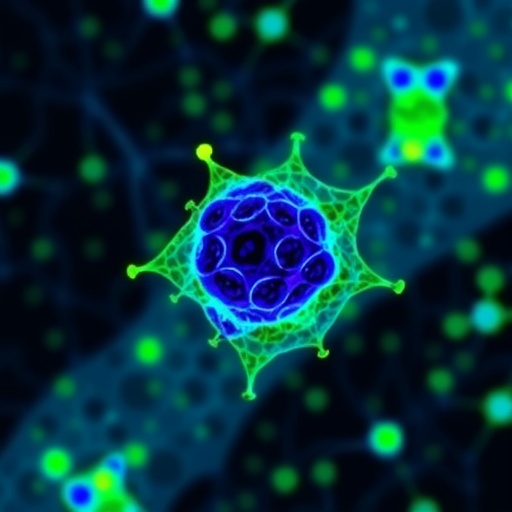In the rapidly evolving landscape of single-cell RNA sequencing (scRNA-seq), the ability to accurately identify and classify cell types within a complex dataset remains a critical challenge. A multinational team of researchers led by The University of Osaka has unveiled a pioneering computational tool, scODIN (Optimized Detection and Inference of Names in scRNA-seq data), designed to revolutionize how scientists decipher cellular identities in single-cell transcriptomic studies. This advancement promises to transform biomedical research by delivering unprecedented precision and automation in the annotation of immune cells, unlocking intricate cellular heterogeneity with a blend of machine learning sophistication and biological insight.
At the heart of scODIN’s innovation lies its hierarchical tiered identification system that addresses the granularity problem inherent in cell typing. Unlike conventional methods that may rigidly assign cells within broad classifications, scODIN adopts a flexible framework whereby it first categorizes cells into broad, highly confident clusters, such as CD4+ T cells, B cells, and monocytes. This initial classification leverages unsupervised algorithms combined with prior biological knowledge to ensure robustness in defining major immune compartments. From this foundation, the system enables refinement into user-specified tiers, allowing researchers to delve into increasingly detailed subsets—ranging from regulatory T cells (Tregs) and helper T cells at Tier 1 to central and effector memory subsets at Tier 2. This hierarchical web of classification mirrors the complex lineage relationships and functional states observed in vivo, thus augmenting biological relevance.
A fundamental hurdle in scRNA-seq data is the presence of cells exhibiting ambiguous or transitional phenotypes, often termed intermediate cell states. Traditional annotation pipelines struggle with such complexity, typically forcing discrete labels where none naturally exist. scODIN innovatively surmounts this by implementing a “double labeling” schema. This approach assigns accepted dual labels to cells that display gene expression signatures spanning two distinct cell identities, thereby acknowledging cellular plasticity and transient differentiation states. Such recognition is paramount in immunology, where dynamic shifts between functional states influence disease progression and therapeutic outcomes.
Another core challenge in scRNA-seq analysis is the dropout phenomenon, where lowly expressed genes fail to be detected, leading to sparse data matrices that compromise cell classification accuracy. To counteract this, scODIN integrates a k-nearest neighbor (kNN) inference algorithm that intelligently extrapolates missing information from phenotypically similar cells within the dataset. By doing so, it enhances the sensitivity of cell type recovery, particularly for rare or transitional populations often underrepresented due to technical dropout. This imputation-like strategy improves both the recall and precision of cell annotation without sacrificing specificity.
The development of scODIN responds to a growing demand in biomedical research for high-throughput, automated methods that circumvent the labor-intensive manual annotation frequently performed by domain experts. Manual curation, while expert-driven, is time-consuming and prone to subjective biases, impeding scalability as datasets grow exponentially. By streamlining the annotation process, scODIN not only accelerates data interpretation but also reduces the risk of inconsistent labeling across studies, thereby promoting reproducibility and comparability in single-cell research worldwide.
scODIN’s impact extends particularly into immunology and oncology, fields where cellular heterogeneity underpins disease mechanisms and therapeutic responses. Understanding the diversity of immune cell subsets and their states can illuminate pathways of immune evasion, inflammation, and tumor microenvironment interactions. The tool’s ability to resolve subtle phenotypic distinctions equips researchers with nuanced insights required to develop precision immunotherapies and personalized medicine strategies, potentially translating to better patient outcomes.
From a technical perspective, scODIN embodies a synthesis of machine learning principles and domain-specific biological constraints. It blends clustering algorithms with supervised inference layers, incorporating user-defined annotations that guide the classification process while allowing flexibility. This hybrid design enables the tool to adapt to diverse datasets and experimental designs, embracing variability inherent to biological systems without compromising rigor.
The widespread adoption of scODIN is anticipated to democratize access to single-cell analytical power beyond specialized computational biology centers. Its user-oriented interface and tier-based approach cater to experimentalists who may not possess deep computational expertise but require reliable and interpretable results. Insights thus gained can be rapidly funneled into hypothesis generation and validation, shortening discovery timelines across diverse investigations in human health and disease.
According to Dr. James Wing, co-senior author of the study, “scODIN empowers researchers to easily navigate and analyze complex scRNA-seq datasets. Its automated and flexible approach not only saves time but also reveals intricate details about cellular populations, opening new doors to understanding disease mechanisms and developing effective treatments.” This endorsement underscores the tool’s potential as a cornerstone in the arsenal of next-generation biomedical informatics.
Beyond the realm of immune cell profiling, the methodological principles underlying scODIN could be extended to other single-cell omics datasets, including single-cell proteomics and spatial transcriptomics. Its modular framework and capacity for hierarchical classification position it as a versatile platform capable of evolving alongside emerging technologies, maintaining relevance in a rapidly advancing field.
Looking forward, the integration of scODIN with large-scale consortium efforts, such as the Human Cell Atlas, could harmonize cell type annotations across datasets and laboratories, resolving discrepancies and fostering a common language in cellular taxonomy. This harmonization is essential for constructing comprehensive cellular maps that underpin future explorations into development, disease, and regeneration.
Overall, the advent of scODIN marks a significant leap toward decoding the complexity encrypted within single cells. By merging computational precision with biological nuance, it unlocks a new era where the vast potential of scRNA-seq data can be harnessed to unravel the cellular underpinnings of health and disease with unprecedented clarity and speed.
Subject of Research: People
Article Title: Optimized Detection and Inference of immune cell type Names in scRNA-seq data
News Publication Date: 21-Aug-2025
References:
Tulyea et al. “Optimized Detection and Inference of immune cell type Names in scRNA-seq data,” The Journal of Immunology, DOI: 10.1093/jimmun/vkaf183, 2025.
Image Credits: Tulyea et al. The Journal of Immunology, 2025, licensed under CC BY-NC
Keywords: Life sciences, Health and medicine, Immunology, Cell biology, Cells, Cancer cells, Single cells




